How to Play
Objective
Be the first player to collect two jewels and return them to the finish space.
Setup
Assemble the game board. Place six jewels in each hand of the idol. The rest of the jewels will not be used in the game. Each player chooses a color and takes the corresponding explorer token and canoe. Each player places their token in their canoe and puts their canoe on the start space. The youngest player gets to go first.
Traversing the Board
At the beginning of a player’s turn, they roll both dice. The number die will tell how many spaces the player can move while the special die tells what special action will occur on this turn (more on this later). Each space/plank counts as one space and players can only move in one direction on each turn. A player can move in any direction as long as they are moving towards a jewel.
To begin the game each player must paddle down the river in order to reach the beach where they can dock their boats. Players may not move onto river spaces if they are not in their canoe. Exiting or entering your boat on the beach only counts as one space. After reaching the beach players will climb the cliff and cross the bridge to reach the Idol and acquire a jewel. When a player acquires a jewel from the idol, they stop immediately and must wait until their next turn to continue moving. After getting their first jewel a player needs to take it back to their boat in order to make it safe so other players can’t steal it. Once a player gets their second jewel they need to get in their canoe and head to the finish space.
In most situations several players can occupy the same space on the game board. Only one player may occupy each space on the cliff at a time. If a player lands on a cliff space already occupied they move to the next available space. Only two players can occupy the idol space at one time. If the idol space is already filled, players need to wait until one of the players leave.
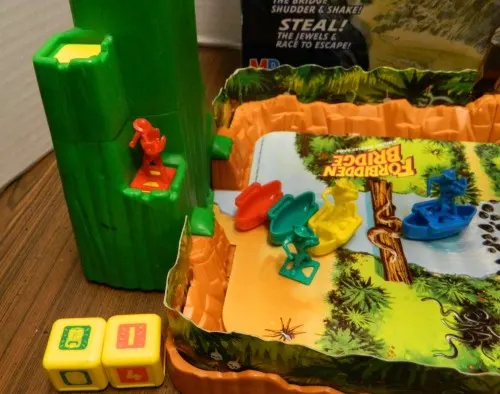
Since the green player has rolled a one they would land on the space already occupied by the red player. The green player would end up moving to the next space past the red player.
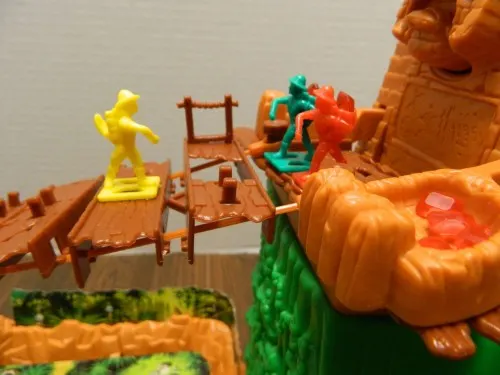
Since the green and red player are currently on the idol space, the yellow player will have to wait until one of them before grabbing a jewel from the idol.
Special Die
The special die includes various symbols that give the player special abilities that they can use in addition to the number they rolled on the number die.
- Idol: This action is mandatory and will be performed before the player makes any movement. The player presses down on the idol’s head which will shake the bridge. If any players or jewels fall, the rules regarding falling apply (see below).
- Explorer Head: The player has the choice of whether they would like to move one of the other players’ pawns that are currently on a bridge plank. This action can be done before or after the player has moved their own piece. With this ability the player can slide the player’s token either left or right on the plank the token currently sits on. A player would want to use this ability to place an opponent’s piece in a position where they are more likely to fall off the bridge.
- Jewel: The jewel icon gives the player an opportunity to steal a jewel from another player’s backpack (cannot steal jewels from a player’s boat). A player can only have one jewel in their backpack at a time so if a player has a jewel in their backpack already, they will not be able to do this action. If at the beginning of their turn a player shares a space with another player who has a jewel, they may steal that jewel and then move the number of spaces rolled. A player can also steal another player’s jewel if they land by exact count on a space occupied by another player that has a jewel in their backpack.
Falling Off the Bridge
When the bridge shakes, players’ explorer tokens or jewels may fall down or fall off the bridge entirely.
Any explorer that falls down stays where they fell until after that player has rolled the dice. If the player rolls the idol symbol they must activate the idol before picking up their piece. The player will then pick up their pawn and place it onto the space where the pawns head was resting. If the head rests between two different spaces, the player can choose which space they want to place their piece on. If the pawn’s head is in the river, the player places the pawn on the nearest land space. If the pawn is hanging from the bridge, the pawn is placed on the space that it is hanging from.
Jewels may also fall out of a player’s backpack. If the jewel falls onto a river space, it is returned to the idol. Otherwise the jewel stays on the space that it landed on. Any player with an empty backpack can then pick up the jewel. The player does not have to land on the space by exact count but their turn ends as soon as they pick up the jewel. If a jewel ends up falling into your canoe, you get to keep the jewel.
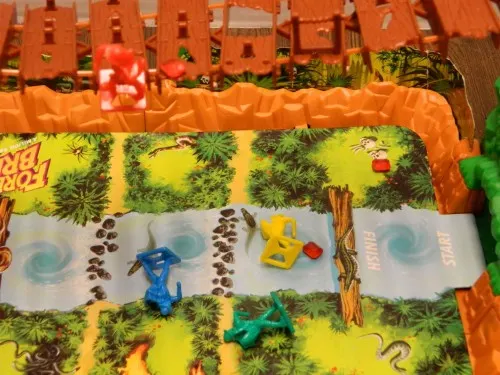
Here is a picture of the possible chaos after the bridge is shaken. The red player will get moved back onto the plank that it is hanging off. The green player can pick either jungle space since its’ head is between the two spaces, The blue player would move to the space below its’ pawn. The yellow player would be moved to the closest space. The jewel on the bridge and in the jungle would stay in place until someone picked them up. The jewel next to the yellow player would be returned to the idol since it is in the river.
Winning the Game
When a player has gotten their second jewel they need to get into their canoe and head towards the finish space. While no player can steal the jewel inside the canoe, any player can still steal the jewel in a player’s backpack. Whoever is the first player to reach the finish line with two jewels wins the game.
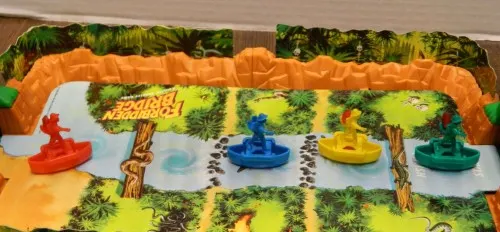
The green player has won the game since they reached the finish space with two jewels (one jewel inside the boat).
Review
Recently at a rummage sale I ran into the game Forbidden Bridge. Growing up as a kid in the late 1980’s and 1990’s I have fond feelings for these type of games. Kids games today just don’t seem to have the originality that the late 1980’s and early 1990’s games had. I never owned Forbidden Bridge as a kid but I was interested in trying it out since even if the game was terrible it was bound to be an interesting experience. It also didn’t hurt that Forbidden Bridge was only $1 at the rummage sale which was a great deal since Forbidden Bridge is a somewhat rare game. While the bridge mechanic is interesting, unfortunately the rest of the game is a pretty average roll and move game.
All the Pieces Come Tumbling Down
The most unique mechanic in Forbidden Bridge is the shaky bridge. Looking at the game it is easily the first thing that stands out. That is a good thing since this mechanic is pretty much the only thing in the entire game that distinguishes Forbidden Bridge from every other roll and move game that has ever come out.
It is hard to explain why but I dare anyone not to get a kick out of it for at least a while. While it is far from deep, it is fun to press down the idol’s head and start the bridge shaking. You will then anxiously watch to see if any of the pawns or jewels will fall off the bridge. It is especially interesting when a pawn is hanging onto the bridge for dear life. It is also quite satisfying to see a pawn or jewel fall off the bridge.
The bridge mechanic is interesting and adds some unique things to the game. Usually you don’t want to fall off the bridge since if you fall off near the idol you are going to lose a lot of progress and will have a hard time catching up. The closer you are to the idol when you fall, the farther you have to traverse to get back to where you previously were. What is strange though is sometimes you may want to be thrown off the bridge. If there is a jewel in the jungle below or you fall with your jewel still in your backpack or on a nearby space, you may actually save time by not having to cross the bridge to get back to your boat.
While the bridge is the most entertaining part of the game, it unfortunately never lives up to its potential. The problem is that it is just so hard to actually fall off the bridge. The idol only shakes the bridge for a couple seconds and the bridge is not shaken hard enough to make any player’s pawn move very far. Unless a pawn is already on the edge of a plank, it is unlikely to fall off the bridge. Add in the railing pieces and all of the notches in the bridge where you can hook your piece, and pieces rarely fall off the bridge. Since the copy I found was missing half of the railing pieces, I played with only half of the railing pieces and it was still so hard to get a pawn to fall off the bridge. I actually recommend not using the railing pieces since that might it a little harder to actually stay on the bridge. In the game I played I think three pawns at max fell down in the entire game.
A Simple Unique Average Roll and Move
The biggest problem with Forbidden Bridge is that outside of the bridge there is nothing new to the game. The game is your typical roll and move game where you roll the dice while trying to collect jewels. The game adds a couple of mechanics where you can steal other player’s jewels or move them around on the bridge but neither really have an impact on the game. As a matter of fact no player was able to steal a single jewel during the entire game. It is just too hard to land on a space occupied by another player, roll the jewel symbol, and not already have a jewel in your backpack.
Being a simple roll and move game means that the game is easy to learn and pick up. While the instructions are considerably longer than you would expect, they probably only take five to ten minutes to read. The game is really easy to explain and children should have no trouble playing the game. I honestly think the recommended age of 7+ is a little high. Outside of the jewels being a choking hazard, I see Forbidden Bridge being the type of game that five year old children could play.
Due to the game’s simplicity, Forbidden Bridge is really more of a children’s game than a family game. That being said adults can have some fun playing the game. While I wouldn’t play the game all the time and I don’t think it is worth its’ cost (see below), I had some fun playing the game since it is such a unique experience. I just wish the game was more strategic since the winner will almost always be determined solely on luck.
Quality Components
Overall I have to give Milton Bradley credit for the components in Forbidden Bridge.
Despite being over twenty years old and showing a decent amount of wear, the Forbidden Bridge that I purchased still worked well. This is testament to the quality of the plastic components included with the game. The idol in particular looks really nice which includes a moving mouth and hands that shake the bridge. I just wish the idol shook the bridge a little harder to make more pawns fall off the bridge.
I love the pawns in Forbidden Bridge. They show a decent amount of detail and I just love the jaunty walking pose that all of the pawns are in. The game even has a backpack carved into the pawns in order to store jewels. The jewels fit nicely in the backpacks but not so tight that they can fall out if the explorer takes a tumble.
I only have a couple complaints with the components. First the cardboard pieces that build the wall around the bottom of the game board will get creased quickly. Second the jewels are kind of small so you could end up losing them easily. Unless you are willing to pony up quite a bit of money, it is unlikely you will find a copy of the game that includes all of the original jewels. Finally I think the dice could have been better. The dice kind of feel hollow which makes them roll kind of funny.
Cult Classic
Forbidden Bridge is one of those classic 1980’s/early 1990’s games that tried to do something new but unfortunately was unsuccessful. Most of these type of games never sold well and thus not a lot of the games were ever produced. Due to their unique mechanics though, there are a lot of people that enjoyed these games which have made some of them quite collectible.
Forbidden Bridge is one of these games. At the time of this post the lowest price on Amazon was over $150 and that copy was missing some of the pieces. On Ebay you can expect to pay more than $100 for a complete copy and at least $60 for an incomplete copy. The two things that are driving the high prices for Forbidden Bridge is people’s nostalgia for the game and the fact that the game was unsuccessful so not a lot of copies were ever made.
While I thought Forbidden Bridge was decent and had some unique ideas, I could not see paying at least $60 for the game. The game is just not good enough to justify that price. The only way I could see paying that much for the game is if you have a lot of nostalgia for it.
Final Verdict
Forbidden Bridge is an all around unique game. Where else can you play a board game where you try to cross a rickety bridge that it is violently shaken by an ancient idol. The bridge mechanic is interesting and could have made for a good game if it worked a little better. Unfortunately the rest of Forbidden Bridge is a pretty average roll and move game.
While I had fun playing Forbidden Bridge, I can’t really recommend picking up the game for one reason, price. Due to nostalgia and rarity, Forbidden Bridge games usually sell for at least $100. Unless you have a lot of nostalgia for the game, I just don’t see the game being worth that much money. If you like these quirky kid’s games though and you can find an affordable copy of the game I think you could have a decent amount of fun with the game. Just don’t expect to play the game all the time.

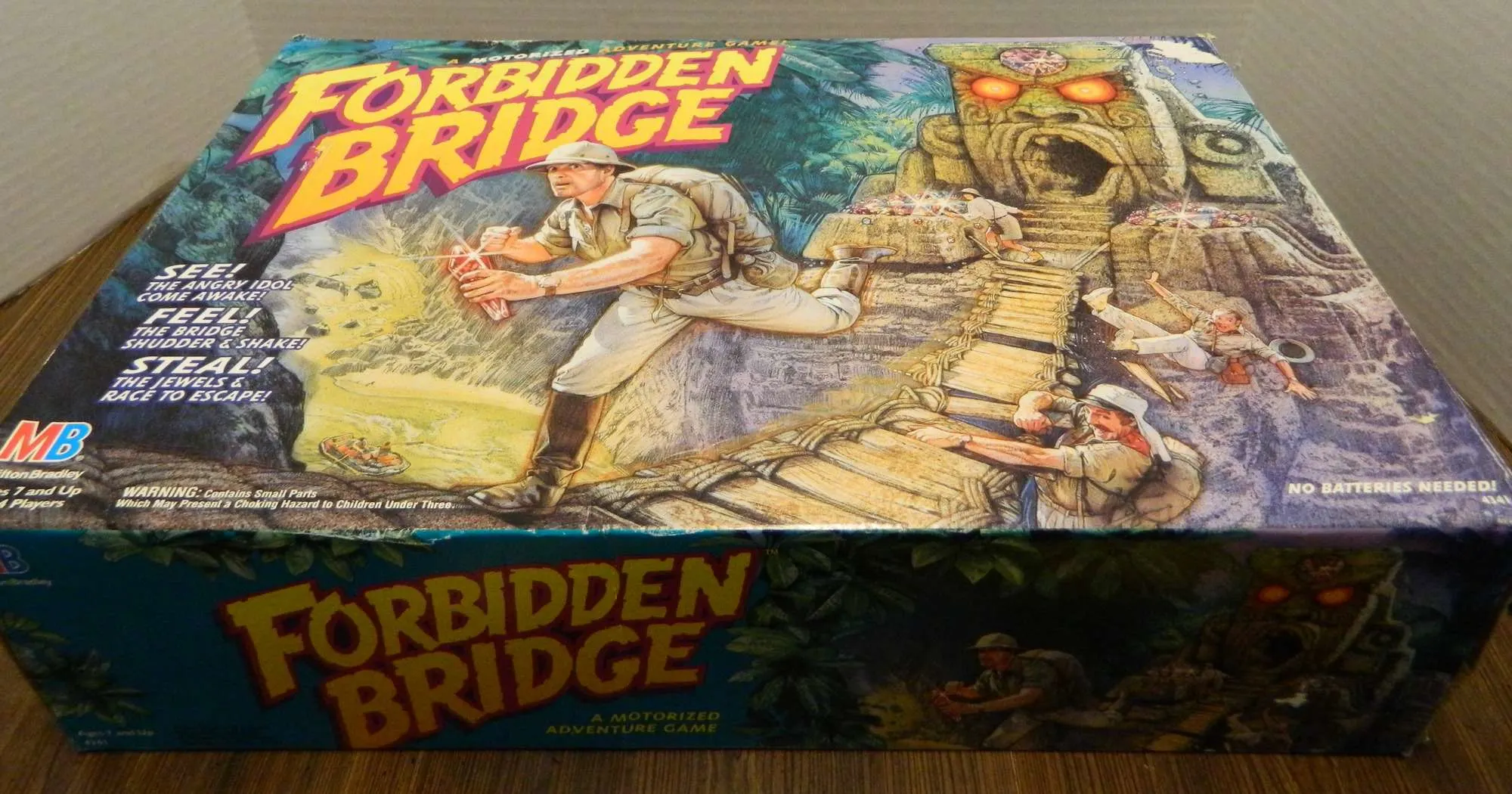
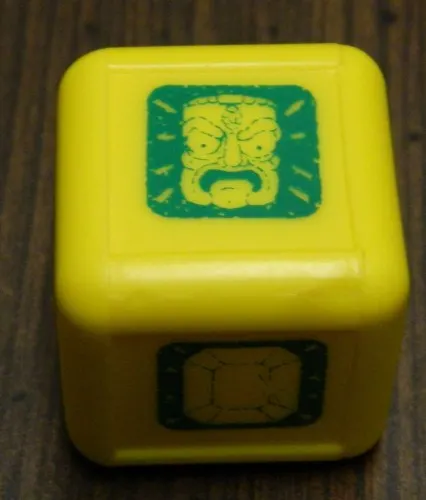
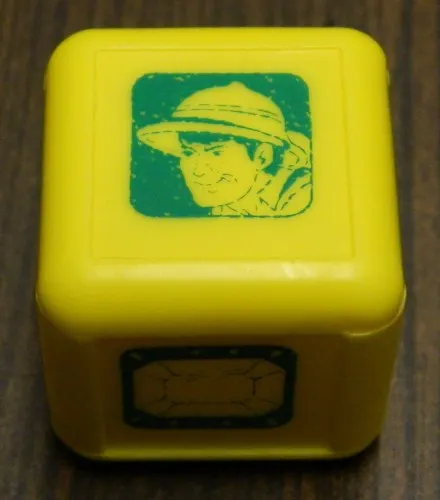
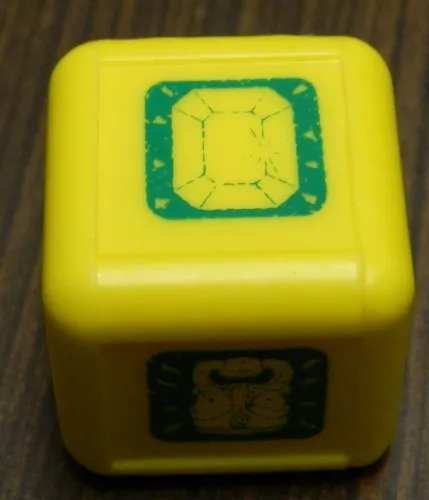
Jo
Saturday 11th of July 2020
Hi I realise this is an old post.... Thought I'd give it a shot. When I was young we had a game very similar to this one. The players had to go across a bridge carrying gold bars stacked on their player. There were crocodiles in the water below that were also mechanical like the bridge that opened their mouths when the bridge tipped. I can't even find a picture of it online and have typed in everything I can think of. It just keeps coming up with forbidden Bridge. It would be around the 90s. There seems to be no trace of it. I wish I could remember the name of it and find it.
Thanks
Jo
Eric Mortensen
Sunday 12th of July 2020
Unfortunately I am not familiar with the game you are describing.
Have you ever tried asking on BoardGameGeek.com before? There are a lot of users on the site that know about a lot of obscure board games. If you would either ask on the Forbidden Bridge forums or the general forums a user on the site may have an idea about what the game could be.
Pam
Saturday 20th of October 2018
Thank you. So much. You were very helpful!!! I didn’t want to ask her more questions cuz I wanted to surprise her. But maybe I’ll have to. It probably balky was of the games you mentioned. She may’ve not been concerned about getting the details right. Take care, Pam
Pam Erselius
Thursday 18th of October 2018
Hello, I enjoyed reading some of your blog today. I have a question about a board game probably from the 90’s involving different colored spaces, dice with numbers, and the possibility of landing in Crocodile Creek. I was reading a devotional today by my favorite speaker/author and she said her son, with whom she was playing, never ever found the instructions in this game. So I was wondering what it could be? I thought it would be fun to actually find the instructions. I found a crocodile creek in a Disney treasure hunt game but the instructions are printed on the board. Might you have an idea? Thank You.
Eric Mortensen
Saturday 20th of October 2018
Hello.
I personally am not familiar with the game that you are describing as I have not played it. I did a little research and couldn't find any games that specifically mention Crocodile Creek. I did find two games that somewhat fit your description though.
In 1988 a game by the name of Crazy Crocodiles was released (it goes by a different name in other languages). It features the colored spaces and the dice with numbers. As I don't own the game though I can't see if there is a Crocodile Creek mentioned in the game.
The other game I came up with is Don't Feed the Gators. It was released in 1992 and it features gators and what looks like a creek. As I own the game, I looked at the gameboard and instructions and neither mention a Crocodile Creek.
Outside of those two games there isn't a lot more I can do without some more information, as there were thousands of board games released around the 90s. I looked up "crocodile", "alligator", and "gator" on Board Game Geek (has a record of most board games that have been released) and those were the only two games that seemed to fit your description. If you can give me some additional information like a publisher, year or other distinguishing information I will try to give you some more information. Otherwise you could try to ask your question on the Board Game Geek forums as the site has a lot of users and one may have heard of your game before and can lead you in the right direction.
I am sorry that I couldn't be of more help.